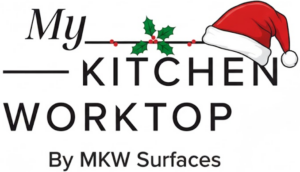Worktop Edge Profiles: Styles, Materials and Key Considerations
At MyKitchenWorktop, we understand that every detail matters when redesigning a kitchen. One element that can have a huge impact on both style and functionality is the edge profile of the worktop. While it may seem like a minor detail, the edge profile can influence the look, safety and durability of your kitchen surface.
In this guide, we explore the most popular worktop edge profiles. You’ll find key advantages and disadvantages, the most suitable materials, and typical thicknesses for each option.
Thinking about renovating your kitchen? Request your quote today and receive expert advice.
1. Splayed Edge
The splayed edge has a gentle angled cut, creating a smooth transition between the top and side surfaces. It adds a subtle dynamic touch to modern kitchen designs.
-
Advantages: Clean design, easy to wipe down, soft visual impact.
-
Disadvantages: Slightly less protection from edge damage.
-
Best materials: Quartz, polished granite.
-
Typical thickness: 20–30 mm.
2. Shark Nose Edge
This profile tapers sharply underneath the surface, creating the illusion of a thinner, floating worktop. It’s popular in sleek, handleless kitchens.
-
Advantages: Ultra-modern appearance, space-saving look.
-
Disadvantages: Less durable on impact if not reinforced.
-
Best materials: Quartz, porcelain.
-
Typical thickness: 20 mm with mitred edge.
Love minimalist design? Request your quote to explore this elegant solution.
3. Dove Chest Edge
Inspired by traditional craftsmanship, this profile combines curved and straight lines for a timeless, luxurious finish.
-
Advantages: Adds elegance and a classic feel.
-
Disadvantages: More intricate, therefore more costly.
-
Best materials: Marble, granite.
-
Typical thickness: 30 mm or thicker.
4. Wide Bevel Edge
A broad chamfer cut defines this profile. It offers strong visual lines and a slightly more pronounced finish than standard bevels. More info here
-
Advantages: Easy to clean, structured appearance.
-
Disadvantages: May trap dust in the angled edge.
-
Best materials: Quartz, granite.
-
Typical thickness: 20–30 mm.
5. Waterfall Edge
The waterfall edge features a tiered, sculptural design that flows down the side of the worktop. It’s ideal for statement islands or classic interiors.
-
Advantages: Unique and decorative, adds a sense of luxury.
-
Disadvantages: More expensive due to complex shaping.
-
Best materials: Marble, quartzite.
-
Typical thickness: 30–40 mm.
6. Reverse Bevel Edge
This profile mimics the Shark Nose edge, but angles upward instead of downward, adding a subtle and refined modern detail.
-
Advantages: Clean look with a twist, adds depth.
-
Disadvantages: Not the most ergonomic to lean on.
-
Best materials: Quartz, porcelain.
-
Typical thickness: 20 mm.
7. Pencil Edge
Also known as a quarter-round edge, this is one of the most common and practical choices. It’s ideal for family kitchens.
-
Advantages: Safe, smooth to the touch, easy to maintain.
-
Disadvantages: Less striking visually.
-
Best materials: All natural stones.
-
Typical thickness: 20–30 mm.
8. Shadow Line Edge
A distinctive edge with a slight gap or shadow beneath the surface, adding a floating visual effect.
-
Advantages: Contemporary and elegant.
-
Disadvantages: Can collect dust in the groove.
-
Best materials: Matt granite, quartz.
-
Typical thickness: 30 mm.
Want your kitchen to stand out? Request your quote and explore our premium finishes.
9. Double Bevel Edge
A more sophisticated version of the wide bevel, this profile features angled cuts on both the top and bottom edges.
-
Advantages: Robust and luxurious appearance.
-
Disadvantages: Bold look may not suit minimal kitchens.
-
Best materials: Marble, quartzite.
-
Typical thickness: 30–40 mm.
10. Shale Edge
With clean and subtle lines, this profile brings an industrial or minimalist vibe to contemporary kitchens.
-
Advantages: Sleek and discreet, ideal for modern homes.
-
Disadvantages: May look too plain in traditional settings.
-
Best materials: Grey granite, porcelain.
-
Typical thickness: 20 mm.
11. Idrís Edge
This angular, architectural profile creates a bold, geometric finish. Perfect for bespoke, high-end kitchens.
-
Advantages: Eye-catching and distinctive.
-
Disadvantages: May clash with soft or rustic styles.
-
Best materials: White quartz, sintered stone.
-
Typical thickness: 20–30 mm.
12. Double Pencil Edge
Rounded on both the top and bottom edges, this profile offers enhanced comfort and safety, especially in busy homes.
-
Advantages: Child-safe, durable, soft look.
-
Disadvantages: Less modern for minimalist tastes.
-
Best materials: Quartz, granite, marble.
-
Typical thickness: 30 mm.
Not sure which edge profile suits your style? Request your quote and let our team help you decide.
Choosing the Right Worktop Edge Profile
The perfect edge profile depends on your kitchen’s style, your choice of material, and how you use the space. For example:
-
Luxury kitchens may benefit from Waterfall, Dove Chest, or Double Bevel edges.
-
Modern and minimalist kitchens are a great match for Shark Nose, Shadow Line, or Shale profiles.
-
Practical family kitchens are best suited to Pencil or Double Pencil edges for comfort and durability.
Worktop Edge Profiles: Styles, Materials and Key Considerations
Conclusion
Worktop edge profiles are more than just decorative details. They shape how your kitchen looks, feels and performs. From classic elegance to sleek minimalism, MyKitchenWorktop offers a wide range of edge finishes to complement any design.
Give your kitchen the finish it deserves. Request your quote today and speak with one of our specialists.




















